Jim Arnott and David Hambley (Dunfermline), Chris Edge (Lauder), Davie Hearn (Edinburgh), were at RAF Barkston Heath near Grantham over the Whitsun Bank Holiday weekend for the British Free Flight Nationals. When we arrived on Friday evening there was a stiff wind blowing and any hopes of a trimming session were dashed. A relaxing wander around the lakes at the Woodland Waters camp site before dinner at Woody’s Bar was an enjoyable alternative.

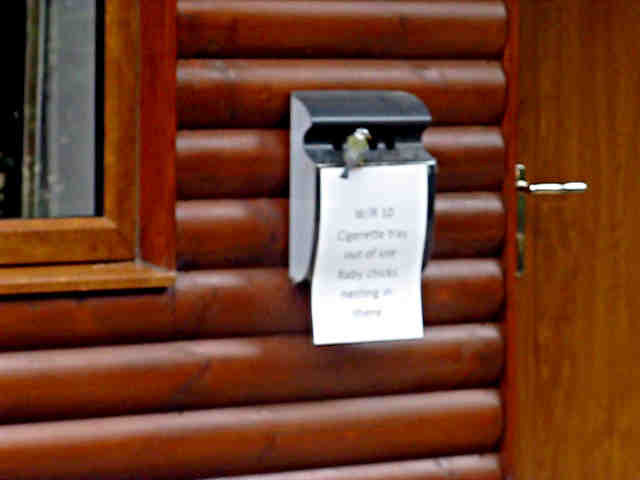
On Saturday morning the weather was quite pleasant with a North West breeze of around 12/15 mph. Jim started flying an “Urchin” with a 50gm rubber motor in the BMFA Rubber event. The first flight was a comfortable maximum (max) flight time in buoyant air which dethermalised (D/T’d) down from 200 ft. It landed just inside the far South West corner of the airfield despite having walked 100 metres upwind of the cars to launch. Jim’s second flight was into a booming thermal and a max was never in doubt. The “Urchin” D/T’d very high up at 2:30 and took another four minutes to return to earth. Thankfully the wind had swung round to the West and Jim had a very good line on the model, going out of the airfield into open farmland. It took a long time to find and he returned some two hours later. The third flight was more marginal, with the Urchin climbing to about 300 ft only, but it hung on to D/T from 50ft for the max which put him into the fly-off (FO). Unfortunately the model suffered serious damage to the wing on landing and so Jim had to select an alternative model for the FO.
Eight fliers qualified for the BMFA Rubber FO so Jim decided to chance his arm with his “Screwtop #17” model which was only “partly trimmed” following repairs after its holiday in woods last year. It turned out that the model was in perfect trim and went booming away for a flight of 5:49, which was lost from sight at tree top level about two miles away. This was good enough for a close 2nd place behind Phil Ball’s winning 6:08 score.

David flew in BMFA Electric with his E36 “Super Pearl”. On his first flight, after a good launch and climb, the model sank quickly in poor air for a very disappointing 1:27.
The second flight with a similar climb was well rewarded with a comfortable 2:30 max.
On David’s third flight, the Super Pearl did not reach its usual height and was then in poor air for an 82 sec flight.
Chris also few in BMFA Electric with his “Joule Box” E36 and he put together three maxes to get him into the FO. There were five fliers in this FO with Chris’s 3:06 flight placing him 4th with the event being won by a 6:44 flight from Chris Redrup.
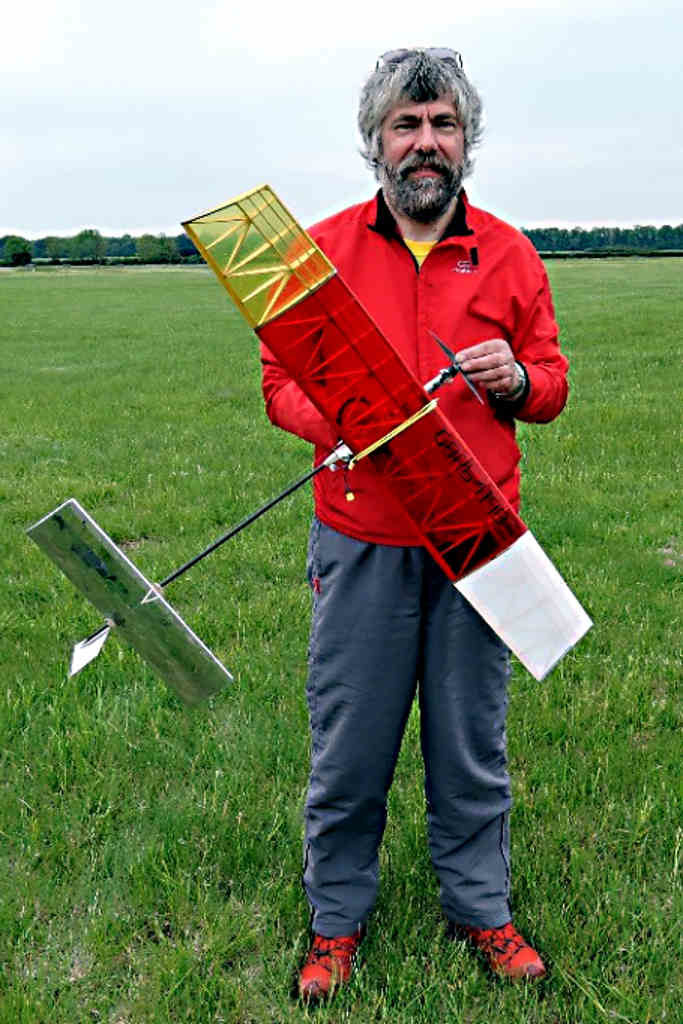
David and Chris also flew in BMFA Glider and had similar outcomes – two good maxes and a dropped flight. David’s first flight with his “Old Peculiar” towed straight overhead and he floated it off gently. Although tight on the glide circle, it held height well for a comfortable max. Having reduced the glide turn a little, he went for his second flight. A healthy pull had the tow line whistling which is usually an indication of lift and he floated the Old Peculiar off. The model now had very little glide turn. If there was lift it had flown out of it, but in neutral air the model had enough performance to max. After another adjustment to the glide rudder, the third flight also gave a positive pull on the tow line but when released the model was still reluctant to turn. This time the air was poor and the model was down in 1:46.
None of Chris’s flights were seen by your roving reporter but his 6:33 earned him 15th place. David’s 6:46 placed him 13th.
Eleven fliers qualified for the FO, which visiting Ukrainian Vasily Beschasney won with a 6:26 flight.
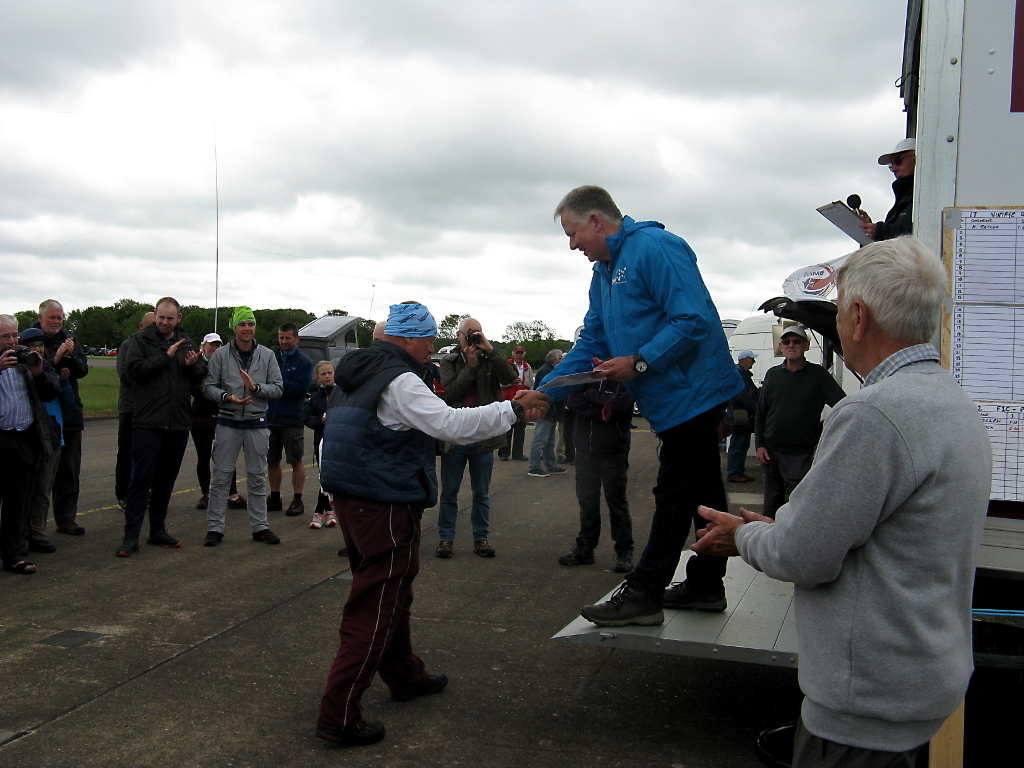
Northern Irishman Maurice Doyle qualified for the Tailless fly-off with this sophisticated and potent model. Poor air in the fly-off left him a minute behind the winner Ted Challis.
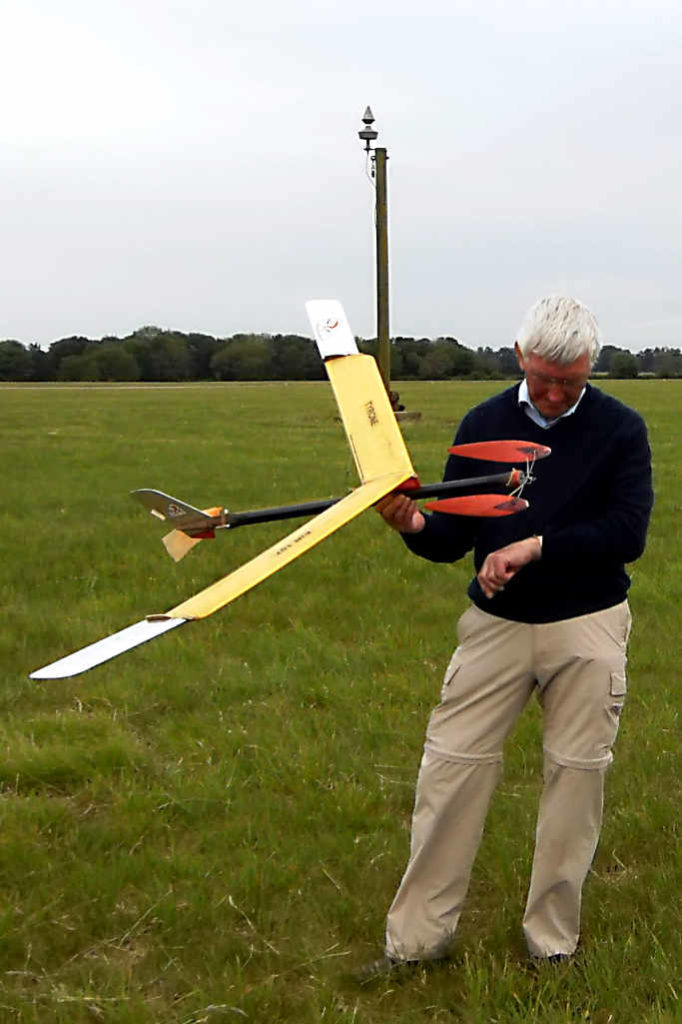
On Sunday the wind was terrible, averaging around 24 mph and gusting to over 30 mph. Chris and Jim were flying in F1a Glider, David elected to sit this one out! International class F1a is a seven (five)-round event with 30 minute time slots in which to make flights. The Contest Director (CD) announced that this contest would be a five round event and the first round would be to a 2 minute max. It was carnage with models crashing everywhere. Only three fliers made the two minute max. Chris was particularly unlucky after an excellent high launch it seemed impossible that his model would fail to max but it was dumped back down in 1:20 falling foul of the “Barkston Curl Over”, a vicious roll-over turbulence coming from Minnetts hill which rises out of Barkston village, a mile upwind.. Jim’s model shot off to the left and he bailed out of the tow to score 1:09.
When the CD was advised that the maxing models had gone out of the airfield, he reduced the max time to 1:30 for the second round. Five fliers managed to max, including Chris. Jim was congratulating himself at getting the model to the top of the line, but then it came off too straight and at such speed that it did a complete loop and recovered low down for a 38 sec flight.
The 1:30 max was maintained for the third round and four fliers achieved it. Chris had a double tow-in for a zero score but this time it was Jim who scored a max. By the end of the third round, none of the competitors had a full score.
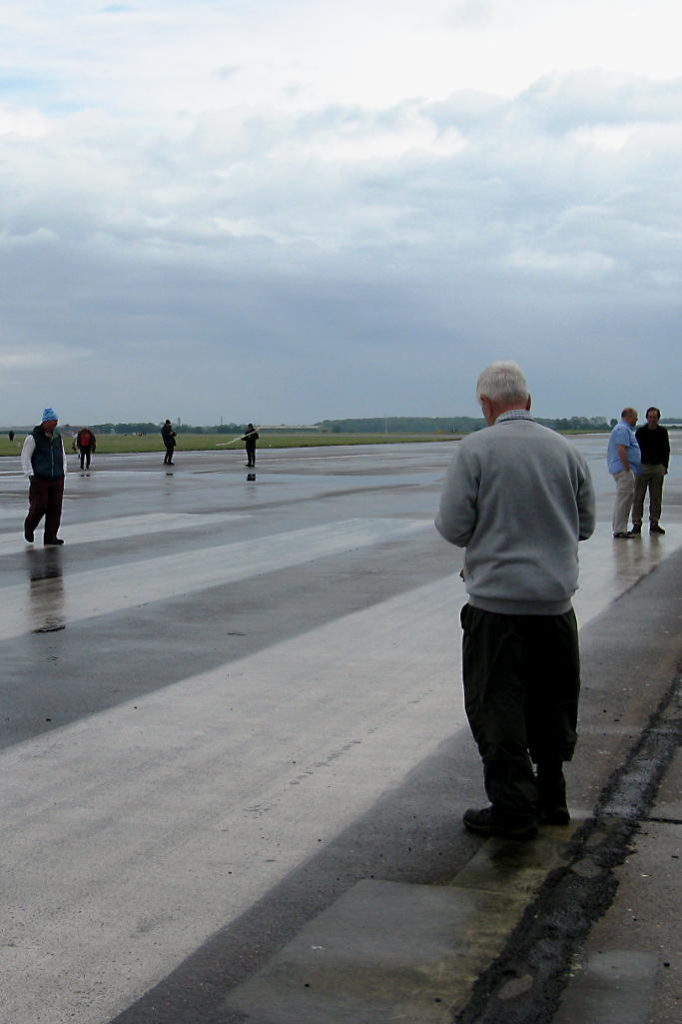
Once more unto the breach. Jim prepares for another “catapult” launch.
The CD moved the max back to 2:00 for rounds four and five, as the wind had eased a trifle. This was not reflected in the scoring as only two fliers scored the max. Chris and Jim again had zero scores with Chris failing to get away again. The cause of Jim’s zero was the curse of the Royal Stewart Tartan. He got the model up and launched nicely but the tow line did not fall away although the model had been pulling more than hard enough to unlatch. The competition rules state that the flight must be timed when the tow line is seen to fall away from the model, hence in Jim’s case a no flight. The model d/t’d at 2 mins confirming that it had unlatched. On retrieval, Jim found that his tartan tow line ribbon was fraying and that a fine red thread had wound itself around the fuselage enough to stop the tow line falling away. Well his Granny told him he should be using the Maclean Tartan !
In the final round, four fliers maxed including Chris and Jim.
Top international glider flyer John Carter deservedly won the event by being only 18 secs short of a full score. John Williams was second some 28 secs further back. These were the only fliers who did not have at least one no score. Jim finished in 4th place and Chris 5th, both creditable performances under the conditions.
On Monday morning, there was still a gusty West wind, averaging about 15mph and gusting over 20mph. There were intermittent thundery downpours during the day. A 2 min max was set for all events.
Jim needed wind protection while winding the rubber motor in his “Gollywock” in Mini-vintage event, but wondered if his old tent flysheet was going to survive the day!
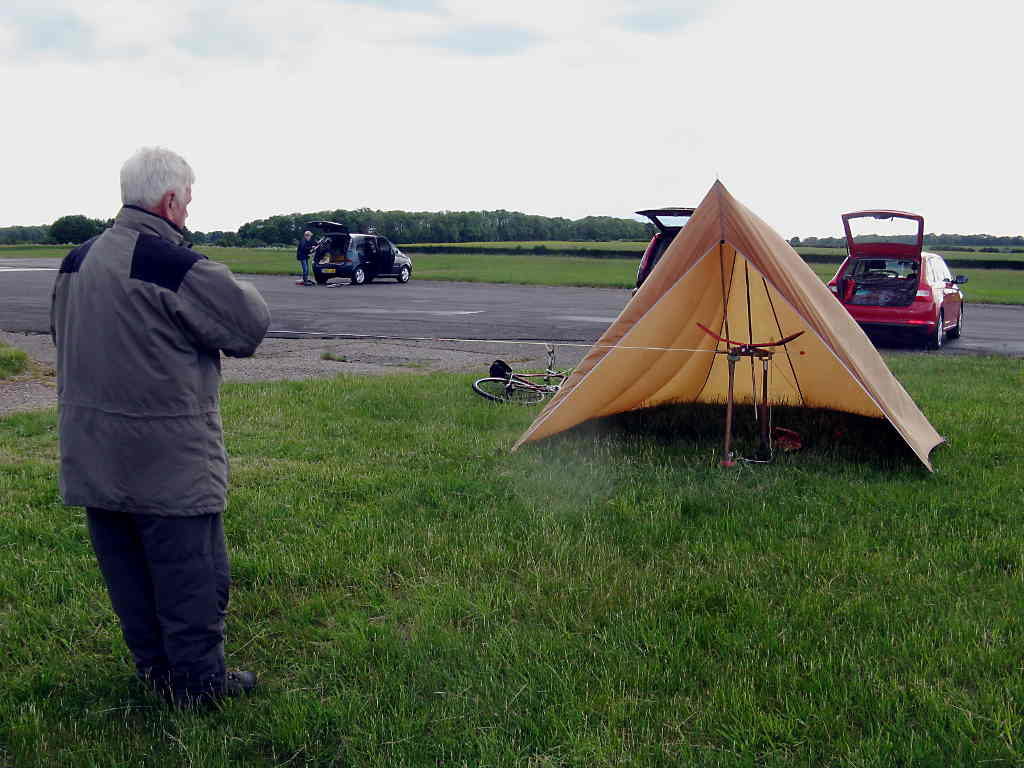
The Gollywock was on good trim and turned in three maxes, with some spectacularly fast climbs and all d/t’ing down from a good height.
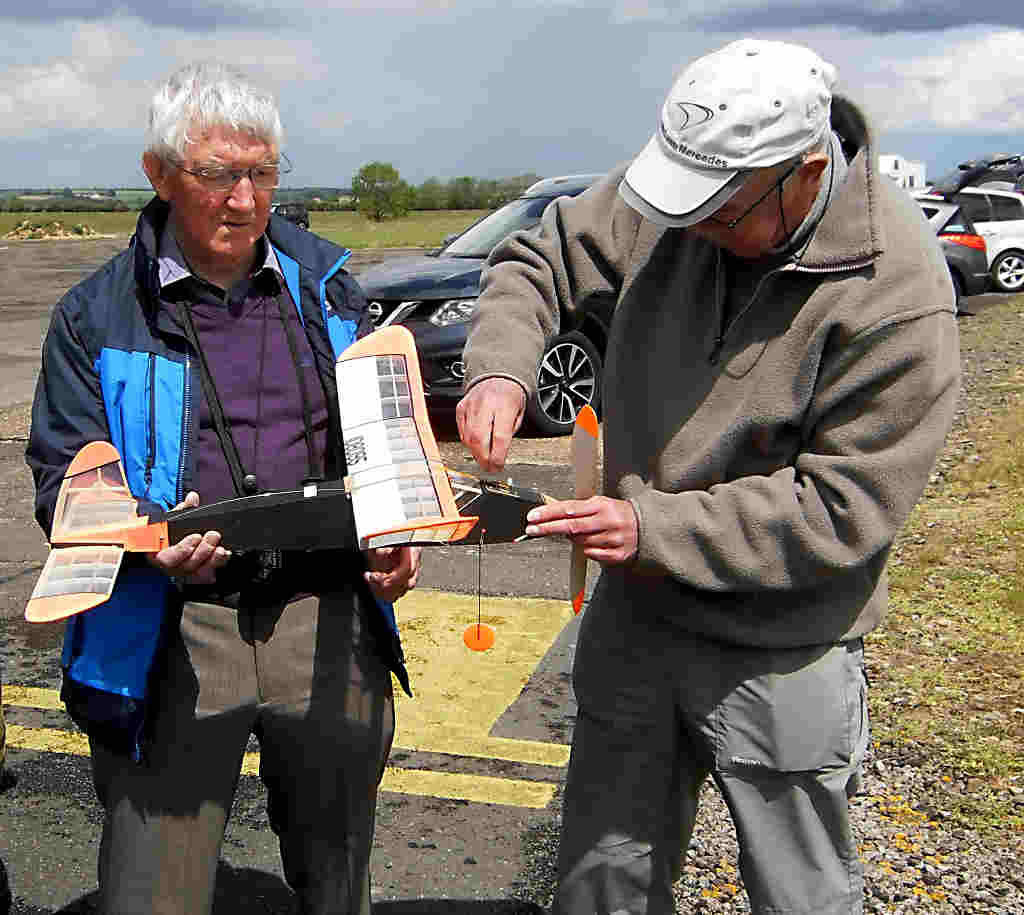
Ulster man Peter Watt lost this pretty Senator with a seven minute flight while getting his second max. He returned in time to qualify for the fly-off with another Senator, but then chose not to compete in the fly-off. A decision he was later to regret.
13 entries in Mini-vintage made it the most popular event of the day. Four fliers qualified for the fly-off. Trish Dennis competing in her first Nationals flying an immaculate Gollywock was first away, followed closely by Spencer Willis’s Senator. Jim watched Spencer’s model go in under power before launching his Gollywock. It was a horrid flight with a prop hanging power stall which destroyed the climb. There was no help from the choice of air and Jim’s model was down in 1:39. Meanwhile Spencer relaunched his Senator and it was climbing away steadily. Trish’s model was down at 2:28. A 2:46 flight from Spencer was the winner.
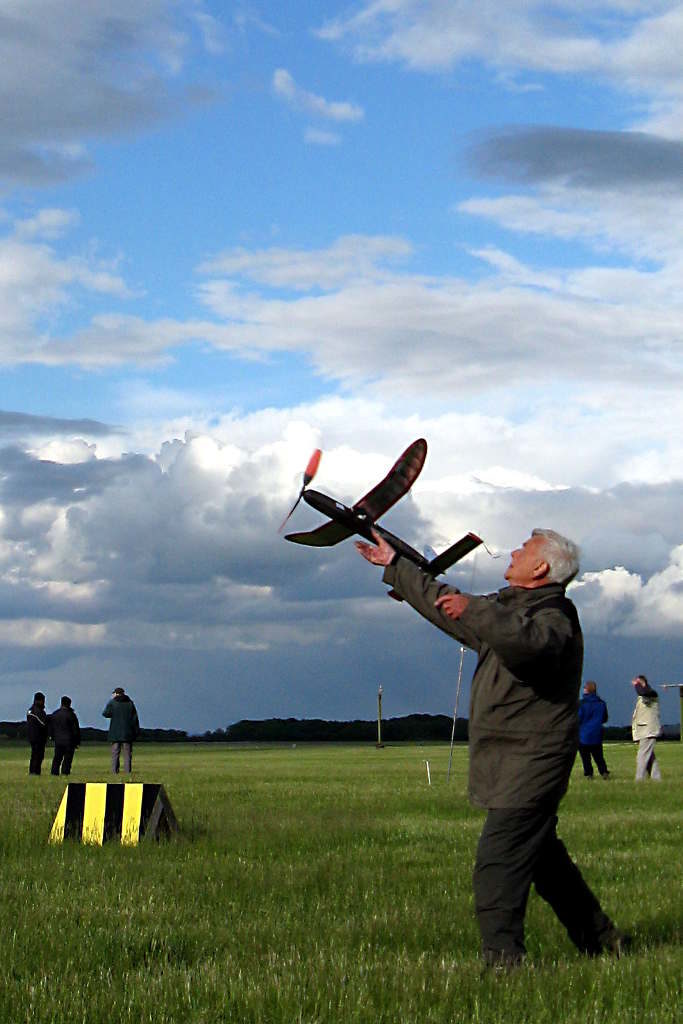
David flew in the E36 contest with his Super Pearl. The first flight had a very good climb pattern and transition into supportive air for a comfortable max. The second flight held on in the glide for a second max after a lower climb, with the Super Pearl going flat after hitting turbulence. Then the problems began !
The first attempt at flight three saw the climb well off pattern, finishing low and the model did not have room to recover from the stall transition. It was down in 15 secs. ( below 20 secs which allowed a second attempt ). David found that the motor mount was cracked, which probably happened on the second flight. This was cyanoed back, but how close to the correct thrust line would the motor be?
The second attempt at flight three was inconclusive as David launched the model too straight, which the SuperPearl never likes and the climb pattern was poor. A disappointing 1:10 flight was the result which gave a 5th place overall.
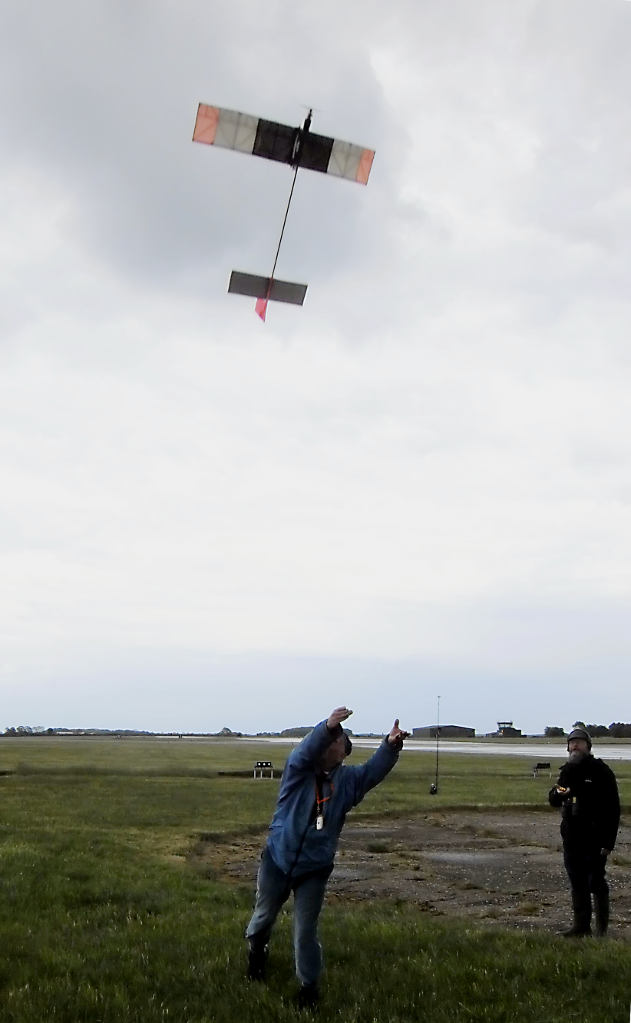
Only two fliers completed their three maxes. Chris Redrup did not contest the FO ( broken or lost model ? ) and Pete Watson had the luxury of being able to d/t his Mini-Satellite model early in a token winning flight.
So we came to the end of another British Nationals of mixed fortunes.
Jim – 2nd in BMFA Rubber, 3rd in Mini Vintage and 4th in F1a
Chris – 4th in BMFA Electric, 15th in BMFA Glider, 5th in F1a,
David – 8th in BMFA Electric, 13th in BMFA Glider, 5th in E36
Our overall championship performance in the various disciples was creditable:-
- Jim 13th in Glider and 6th in Rubber.
- Chris 16th in Glider and 9th in Electric
- David 12th in Electric.
As always an enjoyable experience once the pain is over. What a luxury it is fly and to retrieve on a large airfield. As usual conversation on the trip home is intertwined with many an “if only” and “next time”.
Report: Jim Arnott with additional material David Hambley.
Photos: Jim Arnott, Sue Edge, Chris Edge, David Hambley.
